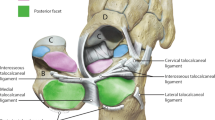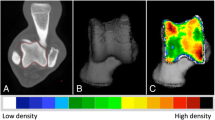Abstract
Purpose
The aim of this study was to investigate the distribution of density of the subchondral bone plate within the articular surfaces of the subtalar and talonavicular joint regarding to its mineralisation and to verify whether a correlation to the mechanical bone strength exists.
Methods
A total of 21 cadaverous lower leg specimens were investigated. Computed tomography osteo-absorptiometry (CT-OAM) was used to display the mineralisation of the subchondral bone plate analysing its density. The mechanical strength was measured by means of indentation testing. The distribution pattern was analysed regarding their dissemination with the main focus on number and location of their maxima. The correlation of both parameters was evaluated by linear regression.
Results
The mineralisation and the mechanical strength were not distributed homogenously throughout the articular surfaces but showed unique and reproducible patterns. The range of absolute values for density and strength varied in between the samples and joint surfaces, but the number and location of the maxima evaluated by both methods showed to be concurring. The coefficient of correlation of both datasets ranged from 0.76 to 0.95 (median 0.88) and showed a linear dependency.
Conclusions
Density distribution and mechanical strength of the subchondral bone plate are significantly associated and can be seen as a mirror of the long-term load intake of a joint. It can be concluded that CT-OAM as a tool to visualize subchondral bone plate density distribution regarding to its mineralisation can be used to indirectly gain information about joint biomechanics in vivo by the use of conventional CT-data.






Similar content being viewed by others
References
Aitken GK, Bourne RB, Finlay JB, Rorabeck CH, Andreae PR (1985) Indentation stiffness of the cancellous bone in the distal human tibia. Clin Orthop Relat Res 201:264–270
Akiyama K, Sakai T, Sugimoto N, Yoshikawa H, Sugamoto K (2012) Three-dimensional distribution of articular cartilage thickness in the elderly talus and calcaneus analyzing the subchondral bone plate density. Osteoarthritis Cartilage 20(4):296–304. doi:10.1016/j.joca.2011.12.014
Aly T (2011) Management of valgus extra-articular calcaneus fracture malunions with a lateral opening wedge osteotomy. J Foot Ankle Surg 50(6):703–706. doi:10.1053/j.jfas.2011.04.006
Ammann P, Rizzoli R (2003) Bone strength and its determinants. Osteoporos Int 14(Suppl 3):S13–S18. doi:10.1007/s00198-002-1345-4
Barbaix E, Van Roy P, Clarys JP (2000) Variations of anatomical elements contributing to subtalar joint stability: intrinsic risk factors for post-traumatic lateral instability of the ankle? Ergonomics 43(10):1718–1725. doi:10.1080/001401300750004122
Beaudoin AJ, Fiore SM, Krause WR, Adelaar RS (1991) Effect of isolated talocalcaneal fusion on contact in the ankle and talonavicular joints. Foot Ankle 12(1):19–25
Bunning PS, Barnett CH (1965) A comparison of adult and foetal talocalcaneal articulations. J Anat 99:71–76
Burkhart KJ, Nowak TE, Blum J, Kuhn S, Welker M, Sternstein W, Mueller LP, Rommens PM (2010) Influence of formalin fixation on the biomechanical properties of human diaphyseal bone. Biomed Tech (Berl) 55(6):361–365. doi:10.1515/BMT.2010.043
Chen YX, Yu GR, Mei J, Zhou JQ, Wang W (2008) Assessment of subtalar joint neutral position: a cadaveric study. Chin Med J (Engl) 121(8):735–739
Hoechel S, Wirz D, Muller-Gerbl M (2012) Density and strength distribution in the human subchondral bone plate of the patella. Int Orthop 36(9):1827–1834. doi:10.1007/s00264-012-1545-2
Hofmann AA, Hammon DJ, Daniels AU (1991) Compressive strength mapping of femoral head trabecular bone. J Rehabil Res Dev 28(2):25–32
Madry H, van Dijk CN, Mueller-Gerbl M (2010) The basic science of the subchondral bone. Knee Surg Sports Traumatol Arthrosc 18(4):419–433. doi:10.1007/s00167-010-1054-z
Mahjoub M, Berenbaum F, Houard X (2012) Why subchondral bone in osteoarthritis? The importance of the cartilage bone interface in osteoarthritis. Osteoporos Int 23(Suppl 8):841–846. doi:10.1007/s00198-012-2161-0
Mall G, Koebke J (1993) Stress fractures of the navicular bone—biomechanical and densitometry studies. Sportverletz Sportschaden 7(2):73–77. doi:10.1055/s-2007-993486
Milz S, Eckstein F, Putz R (1997) Thickness distribution of the subchondral mineralization zone of the trochlear notch and its correlation with the cartilage thickness: an expression of functional adaptation to mechanical stress acting on the humeroulnar joint? Anat Rec 248(2):189–197
Muhlhofer H, Ercan Y, Drews S, Matsuura M, Meissner J, Linsenmaier U, Putz R, Muller-Gerbl M (2009) Mineralisation and mechanical strength of the subchondral bone plate of the inferior tibial facies. Surg Radiol Anat 31(4):237–243. doi:10.1007/s00276-008-0430-6
Mulcahy DM, McCormack DM, Stephens MM (1998) Intra-articular calcaneal fractures: effect of open reduction and internal fixation on the contact characteristics of the subtalar joint. Foot Ankle Int 19(12):842–848
Muller-Gerbl M (1998) The subchondral bone plate. Adv Anat Embryol Cell Biol 141:III–XI, 1–134
Perry J (1983) Anatomy and biomechanics of the hindfoot. Clin Orthop Relat Res 177:9–15
Radin EL, Rose RM (1986) Role of subchondral bone in the initiation and progression of cartilage damage. Clin Orthop Relat Res 213:34–40
Reeck J, Felten N, McCormack AP, Kiser P, Tencer AF, Sangeorzan BJ (1998) Support of the talus: a biomechanical investigation of the contributions of the talonavicular and talocalcaneal joints, and the superomedial calcaneonavicular ligament. Foot Ankle Int 19(10):674–682
Saitoh S, Nakatsuchi Y, Latta L, Milne E (1994) Distribution of bone mineral density and bone strength of the proximal humerus. J Shoulder Elbow Surg 3(4):234–242. doi:10.1016/S1058-2746(09)80041-4
Sangeorzan BJ, Wagner UA, Harrington RM, Tencer AF (1992) Contact characteristics of the subtalar joint: the effect of talar neck misalignment. J Orthop Res 10(4):544–551. doi:10.1002/jor.1100100409
Seeman E, Delmas PD (2006) Bone quality—the material and structural basis of bone strength and fragility. N Engl J Med 354(21):2250–2261. doi:10.1056/NEJMra053077
Shahabpour M, Deville A, Van Roy P, Vaes P, De Mey J, De Maeseneer M (2011) Magnetic resonance imaging of anatomical variants of the subtalar joint. Surg Radiol Anat 33(7):623–630. doi:10.1007/s00276-011-0788-8
Sharada R, Sneha K, Gupta C, Pai SR, Rairam GB (2012) Non-metrical study of the pattern of talar articular facets in south Indian dry calcanei. Surg Radiol Anat 34(6):487–491. doi:10.1007/s00276-012-0939-6
Smith CB, Smith DA (1976) Relations between age, mineral density and mechanical properties of human femoral compacta. Acta Orthop Scand 47(5):496–502
Unger S, Blauth M, Schmoelz W (2010) Effects of three different preservation methods on the mechanical properties of human and bovine cortical bone. Bone 47(6):1048–1053. doi:10.1016/j.bone.2010.08.012
van Haaren EH, van der Zwaard BC, van der Veen AJ, Heyligers IC, Wuisman PI, Smit TH (2008) Effect of long-term preservation on the mechanical properties of cortical bone in goats. Acta Orthop 79(5):708–716. doi:10.1080/17453670810016759
Wagner UA, Sangeorzan BJ, Harrington RM, Tencer AF (1992) Contact characteristics of the subtalar joint: load distribution between the anterior and posterior facets. J Orthop Res 10(4):535–543. doi:10.1002/jor.1100100408
Acknowledgments
We would like to thank Mrs. Mireille Toranelli for the software-support and Mrs. Nicole Hauser for her help with management of CT-data. Furthermore, the authors received no grant or sources of financial support related to the topic or topics of this article.
Conflict of interest
The authors declare that they have no conflict of interest.
Author information
Authors and Affiliations
Corresponding author
Rights and permissions
About this article
Cite this article
Mueller, F., Hoechel, S., Klaws, J. et al. The subtalar and talonavicular joints: a way to access the long-term load intake using conventional CT-data. Surg Radiol Anat 36, 463–472 (2014). https://doi.org/10.1007/s00276-013-1205-2
Received:
Accepted:
Published:
Issue Date:
DOI: https://doi.org/10.1007/s00276-013-1205-2




